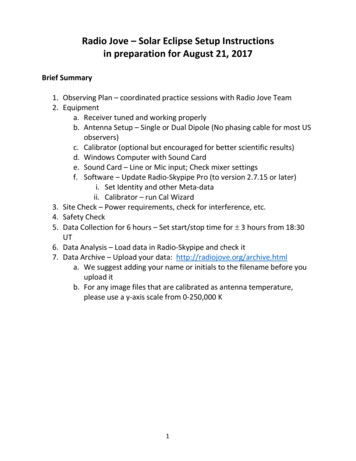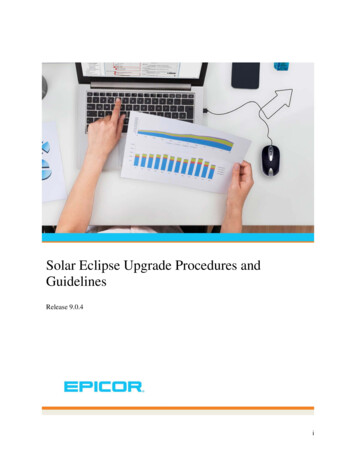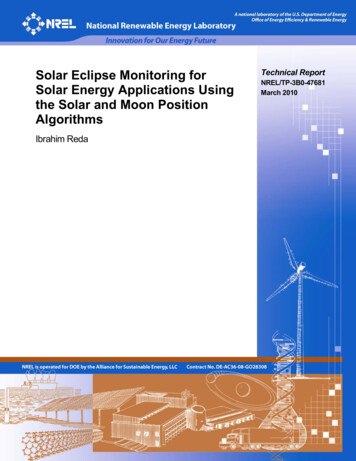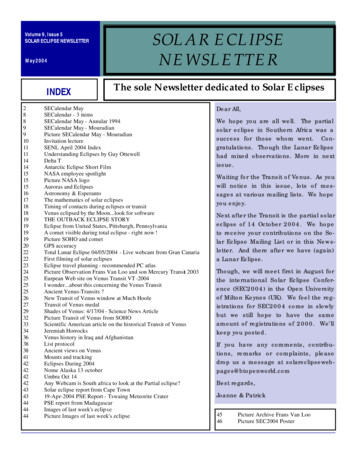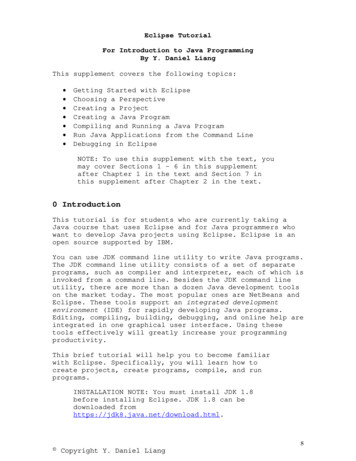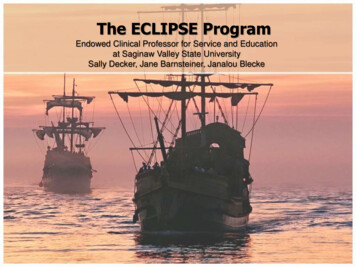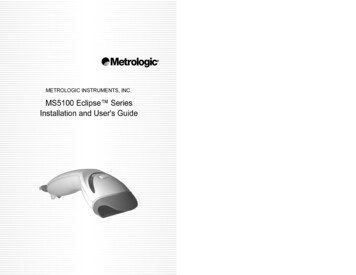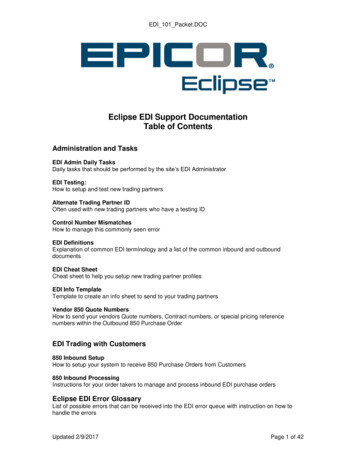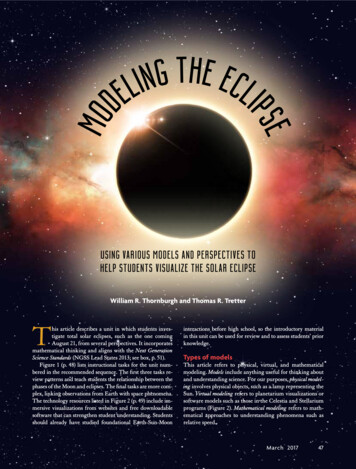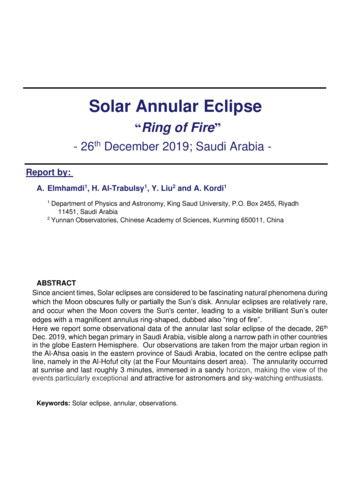
Transcription
Solar Annular Eclipse“Ring of Fire”- 26th December 2019; Saudi Arabia Report by:A. Elmhamdi1, H. Al-Trabulsy1, Y. Liu2 and A. Kordi11Department of Physics and Astronomy, King Saud University, P.O. Box 2455, Riyadh11451, Saudi Arabia2Yunnan Observatories, Chinese Academy of Sciences, Kunming 650011, ChinaABSTRACTSince ancient times, Solar eclipses are considered to be fascinating natural phenomena duringwhich the Moon obscures fully or partially the Sun’s disk. Annular eclipses are relatively rare,and occur when the Moon covers the Sun's center, leading to a visible brilliant Sun’s outeredges with a magnificent annulus ring-shaped, dubbed also “ring of fire”.Here we report some observational data of the annular last solar eclipse of the decade, 26thDec. 2019, which began primary in Saudi Arabia, visible along a narrow path in other countriesin the globe Eastern Hemisphere. Our observations are taken from the major urban region inthe Al-Ahsa oasis in the eastern province of Saudi Arabia, located on the centre eclipse pathline, namely in the Al-Hofuf city (at the Four Mountains desert area). The annularity occurredat sunrise and last roughly 3 minutes, immersed in a sandy horizon, making the view of theevents particularly exceptional and attractive for astronomers and sky-watching enthusiasts.Keywords: Solar eclipse, annular, observations.
Solar Annular Eclipse-KSAContentsAbstract . 1Observation Site and Circumstances . 31.The four-Mountains location . 32.Eclipse Characteristics . 4Equipment and Tools . 51.Setup description . 52.Imaging the event. 5Summary . 6References . 72
Solar Annular Eclipse-KSAObservation Site and Circumstances1. The Four-Mountains locationOn 26 December 2019 the Sun rose in state of partial eclipse in most of the regions of the Kingdomof Saudi Arabia (with various proportions). In Al-Hofuf city in the province of Al-Ahsa the Sun hasrisen at 6:25am, local time, until the annular eclipse peaked at 6:36am continuing for almost 3mn,then it turns into a partial eclipse, lasting till 7:49am.For a better follow-up of the event, our observations were made at Four-Mountains area, Jabal AlArba’a in arabic, along the central main line of the eclipse track, situated on the road leading toQatar country (See the site images in Fig. 1).Figure 1: The Four-Mountains site, at AL-Hofuf city, where the observations were made.Figure 2 highlights the visibility map of the solar eclipse, with the bold line marking the centre of thepath and where the annular eclipse lasted longest. The shaded area refers to the annular solareclipse; however, the eclipse duration gets shorter as we move closer to the edges (generated fromNASA Goddard Space flight Center1 [1]).1Map sourced from NASA Goddard Space flight Center: GSFC Eclipse Web Site, displaying the visibility of the annular solar eclipse.3
Solar Annular Eclipse-KSAFigure 2: Map of the annular eclipse path across an east-southern strip in Saudi Arabia.The zoomed view-box highlights our observation site at Al-Hofuf city [1].2. Eclipse characteristicsIn table 1, we summarize the main important annular eclipse circumstances and characteristics.Some of the shown data are generated from Google map Solar Eclipses Xavier-Jubier website [2].Table1: Basic Solar Annular Eclipse Circumstances Observing Site &Location Site: Four Mountains Camp [Jabal Al-Arba](AlHofuf City-AlAhsa Region; Saudi Arabia)Location Lat: 25 17′ 13″ NLong: 49 42′ 54″ ETiming Sequence(local time: UT 3h)26th December 2019 Start of partial eclipse (1st contact C1):Sunrise (with partial eclipse in progress):Start of annular eclipse (2nd contact C2):Maximum annular eclipse:06:36End of annular eclipse (3rd contact C3):End of partial eclipse (4th contact C4):05:3206:2806:3406:3707:48Annular Solar Eclipseduration2m 59.2s (2m 52.5s with lunar limb corrected)“Moon/Sun” size ratio(at the maximumEclipse) 0.956The obscured Sun’s disksurface at maximumeclipse 91.53%4
Solar Annular Eclipse-KSAEquipment and Tools1. Setup descriptionTo image the Sun during both the annular and partial phases, three main instruments are used inour setup, namely:a) iOptron Solar 60, 60mm refractor, GoTo GPS portable computerized Telescope withSolarlite solar filter and electronic eyepiece, and with the following key features, Removable Front Solar Filter 60mm (aperture) Achromatic Doublet Refractor 360mm Focal Length, f/6 Focal Ratio Resolution Power: 1.93 arc secb) The Orion StarShoot Solar System Color Imager IV: consists of 1/3" format CMOS imagingsensor with a 1280 x 1024 pixel layout. Each pixel is a mere 3.6µm x 3.6µm in size for imageresolution in 24-bit RGB color. The imager is accompanied with an image processingsoftware. The Orion StarShoot imager is mainly used through the telescope eyepiece,allowing to view real-time target images on the computer screen.c) The digital Sony Alpha 58 camera also known as Sony A58 (model name SLT-A58 with 20.1megapixel resolution across the 100-16000 ISO range).2. Imaging the eventWe follow and document the eclipse during both the annular and partial phases. Figure 3 reportsa sample of our observations covering the main phases, starting from the rising crescent Sun(left upper image-just slightly greater than 1degree from the horizon). The maximum annularphase is highlighted in the zoomed middle panel, with the magnificent and impressive ring-likeshape.The partial phase is displayed in the bottom-line image sequence, until the last contact around 07:48pm (local time).5
Solar Annular Eclipse-KSAFigure 3: Sample of image sequence of the annular phase (upper line panels) and the partial phase (bottomline panels) of the 26 Dec 2019 solar eclipse, observed in the Four-Mountains area, Al-Hofuf city inthe Kingdom of Saudi Arabia. The middle panel is a zoomed view of the ring-like obscured Sun atmaximum annularity.SummarySolar eclipses, in particular total and annular, give scientists the opportunity to make significantscientific measurements. For example, allow understand the patterns and structures of the solarcorona that cannot usually be studied during day observations. Also, observations during suchevents help to measure accurately the diameter of the Sun and as well its variations over time. Inaddition, eclipses enable the analysis of the shape of the Moon.Importantly, in order to reveal significant information about the scattering process in the atmosphere,and hence decide on the quality of a given site for solar Coronal observations (coronagraph sitesurvey purposes), some scientific investigations efforts successfully utilized the sky brightnessmonitor (SBM) to measure the sky brightness and thus test its performance and sensitivity, duringthe solar annular eclipse phenomenon [3].The present report describes the occurrence of the peculiar annular solar eclipse in Al-Hofuf cityarea in the eastern province of Saudi Arabia on 26th December 2019. Such annular eclipse eventhappened rarely over the country. Indeed, and according to historical data, the latest observedannular eclipse was about 97 years ago (22 March 1922). The 26th December 2019 eclipse belongsto Solar eclipse Saros 1322 [4].2The periodicity and recurrence of solar eclipses is governed by the Saros cycle, a period of approximately 6,585.3 days (18years 11 days 8 hours). Any two eclipses separated by one Saros cycle share very similar characteristics and geometries [4].6
Solar Annular Eclipse-KSASolar annular eclipses are one of the most spectacular astronomical phenomena, that occurs whenthe Moon is so far away from the Earth, resulting the Moon’s apparent diameter to be smaller thanthat of the Sun, blocking most of the central Sun's light, and causing the Sun’s outer edge to be stillvisible and forms an annulus-like shape “ring of fire” around the Moon. The eclipse event in theFour-Mountains location consists the earliest observed in its path. Right after the sunrise, undergood weather conditions, the Sun’s disk appeared obscured by the Moon’s shadow with a reddishamazing panoramic view owing to the sandy desert location. The visible eclipse, from sunrise, lastedabout 1h20mn with approximately 3mn in the annular phase.It is undoubtedly interesting to coordinate and conduct further observational campaigns during futurelunar and solar eclipses. Such activities and follow-up of these fascinating astronomical naturalphenomena might play an important role not only from a research and scientific point of views butalso in the context of attracting public interests in the sky, astronomy science and space mysteries.References[1] “NASA Goddard Space flight Center: GSFC Eclipse Web [2] “Xavier Jubier Google map Solar Eclipses Web Site”,http://xjubier.free.fr/en/site pages/Solar Eclipses.html[3] “Using a New Sky Brightness Monitor to Observe the Annular Solar Eclipse on 15 January 2010”Y. Liu, Y.-D. Shen, X.-F. Zhang, N.-P. Liu; 2012, Solar Phys. 279, 561.[4] “NASA Saros Series Catalog of Solar Eclipses Web os132.html7
Solar Annular Eclipse-KSA 6 Figure 3: Sample of image sequence of the annular phase (upper line panels) and the partial phase (bottom line panels) of the 26 Dec 2019 solar eclipse, observed in the Four-Mountains area, Al-Hofuf city in the Kingdom of Saudi Arabia. The middl

